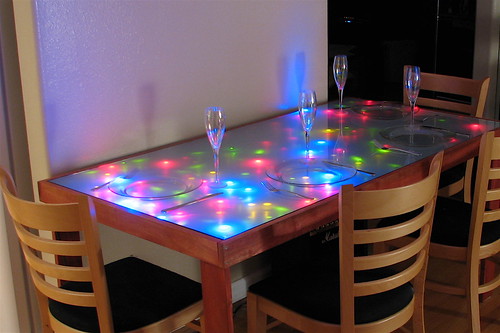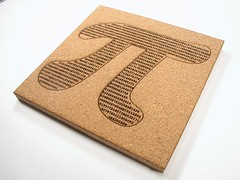Category Archives: Art
Ice Cream Gyoza
Gyoza, or Japanese potstickers, are not normally served with chocolate fudge sauce, but ice cream gyoza are!
Here’s how to make your own cookie dough and ice cream dessert gyoza.
But if we took the bones out…
SymmetriSketch: A simple app for playing with symmetry
We were recently contacted by a mathematics instructor, who suggested that it might be interesting to have a program like Snowflake, but with the option of picking and choosing different symmetry properties.
Natural snowflakes have (approximate) sixfold rotation symmetry plus reflection symmetry. However, a lot of things that you can draw by hand have absolutely no resemblance to snowflakes at all– and it is somewhat fun to explicitly play with the rules.
Our new program, SymmetriSketch, sticks to the same basic design principles as Snowflake: it’s cross platform, open source, and able to export a true vector drawing with a closed path. However, SymmetriSketch is a much more flexible program that allows you to play with different symmetries, and create all kinds of different things that would never be mistaken for frozen water.
Here’s what it looks like when the program first opens:
The initial shape is an overall pentagon– an object with five-fold rotation symmetry and reflection symmetry. The figure is generated by taking the editable slice– highlighted here and when you start the program– and reflecting and rotating it to complete the full shape that you see.
Within the editable slice, you can also see three highlighted control points that can be dragged around. There is control point at every vertex and at the midpoint of every line segment between two vertices. If you drag a control point that is the midpoint of a line segment, it turns that control point into a new vertex. That new vertex also gets new control points at the midpoints to its neighbors.
Every vertex point can be moved to any location on the screen with the exception of the vertex that is initially at the top point of the pentagon– that vertex is constrained to move along the vertical axis– the axis of reflection symmetry.
The controls are purposefully kept simple. There are two symmetry controls– for the order of rotational symmetry and to toggle reflection– which you can change in the lower left hand corner of the screen.
The number, with its +/- controls, refers to the order of discrete rotational symmetry. If the number shown is n, then n-fold rotational symmetry is applied, which means that the displayed object is unchanged when rotated by 360 degrees/n. In the screenshot above, 9-fold rotational symmetry is applied.
Orders from 1 to 99 are allowed– note that 1-fold rotational symmetry is “no symmetry at all” since it requires 360/1 = 360 degrees of rotation to return to the original shape.
The second control is for reflection symmetry, and toggles between “reflect” or “rot. only,” where it either does, or does not apply a mirror reflection across the vertical axis.
With reflection symmetry turned off, the figure is drawn with pure rotational symmetry. (This screenshot was taken while editing the shape, and you can see control points, indicated by little circles.)
Continue reading SymmetriSketch: A simple app for playing with symmetry
Precision in packaging
Sichuan peppercorns, oh yeah! Raven of Made with Molecules after eating them wrote, “There’s a war in my mouth.” They create a riot of numbing and tingling sensations, particularly if you can get relatively fresh ones (i.e. not stale from sitting around in a Whole Foods bulk bin). Raven links to an abstract about the particular anesthetic-sensitive potassium channels inhibited by hydroxy-alpha-sanshool, one of the components of sichuan peppercorns that make them so exciting.
Science aside, we recently found some in a local asian grocery store, and were particularly struck by the packaging. American packaging often has annoying disclaimers about how contents are packed by weight and may have settled. These peppercorns were not only weighed, but the precision of the scale is indicated! If only all packaging was so straightforward. I was going to complain that the package doesn’t say what kind of peppercorns were inside (sichuan peppercorns are not related to other peppercorns) but then realized that the Chinese characters are specific to these “flower peppers” even if the English words are more general. In any case, the reddish husks are recognizable through the bag.
Evil Mad Scientist Laboratories: Year 3
Happy birthday to us! Evil Mad Scientist Laboratories is now three years old.
To celebrate, we’re rounding up our most interesting projects from this past year.
Quick projects and observations:

The monetary density of things

Contact Lens Case Small Parts Tray
Simple LED Projects:

Quick, easy, temporary, and beautiful LED garden lights
Food Hacking:

South Indian Restaurant Menu Decoder

Improved Custom Message Hearts
CandyFab
Papercraft
Electronics Projects

Interactive LED Dining Table Circuit

Dark detecting jack-o’-lantern
Kit Projects
Crafty Projects
Microcontroller Projects

Tennis for Two, a video game from 1958

Scariest Jack-o’-Lantern of 2008
Geek Design
(Whew!)
Making a Frabjous
George W. Hart is a professor at Stony Brook and is one of our favorite artists, making a wide variety of stunning geometric sculptures. On his of his many works that has particularly captivated us for some time is a sculpture called Frabjous.
When we realized that George had posted a template for this sculpture we dropped everything, grabbed the cardboard and hot glue, and raced to build our own.
Continue reading Making a Frabjous
Soft Circuit Merit Badge

The proliferation of spoof, nerd, science, and electronics merit badges has demonstrated that geeks like to show off their skills and accomplishments. One skill is particularly appropriate for the format: soft circuitry. By building your own soft circuit onto an actual badge you can demonstrate your mastery.

The size of the badge is just right for a simple circuit with a battery, a switch and an LED. The crowning touch is that the stitched circuitry can form the circuit diagram as well.
The Amazon Kindling
This week’s project is a collaboration with Rob from the always-entertaining-but-hard-to-describe science/prank/DIY/investigative journalism site Cockeyed.com. He had the brilliant idea of making an Amazon Kindling— a wireless wooden e-book (which uses no electricity….), and we were pleased to help out. You can read his writeup here. It came out well, and you can even use it as firewood when you’re done reading.
Amongst his other projects, Rob has a long and remarkable history of putting unusual objects on eBay– and apparently the Kindling qualifies– his auction is here.
Update 5/14, 11:55 PM: eBay has pulled the auction. That’s surprising– it was accurately described, listed in the “sculpture” category, and very clearly a parody. (No sense of humor, some people.)
Update 5/15, 12:15 AM: The auction appears to have been reinstated. (Have to keep an eye on this.)
Stickers for the Organic Gardener
The influence of the Slow Food movement is increasing, and gardening is getting ever more popular. Even the tech bloggers are posting about local pollinators and getting beehives. In this environment, it is fitting that a new use has been found for our Now Slower and with More Bugs stickers, which were first seen in the wild back in December 2007. If you find a good use for them, we’d love to see pictures in the flickr auxiliary!
(Thanks, Lorien!)
Photos by Lorien Tersey


























































